AAAART INNNNN SPAAAAAACE!!!!
Space Shuttle Program Insignia Edition
Exploring the intersection of spaceflight history, pop culture, and space art.
Fifteen years ago this month I had the distinct pleasure of witnessing my artwork launch into Earth orbit aboard the Space Shuttle. In this edition of Creating Space, I recount the experience of seeing Atlantis lift off the pad and climb into the heavens. You will hear what it was like when you listen to the audio recording I made at the site. And, I describe the contest that led to the selection of a patch to commemorate the Space Shuttle Program, as well as my design entry for the competition.
Are you new to Creating Space? It’s the NERDSletter that explores the intersection of spaceflight history, pop culture, and space art. You can find this and all other posts at creating-space.art.
The First Final Launch of Atlantis
May 14, 2010, was a very special day. I experienced what at that time was to be one of the last remaining space thrills on the planet. I had a front row seat for the last scheduled launch of Space Shuttle Atlantis. Only two more Shuttle launches remained on NASA's then-current plans, so this was fast becoming a rare sight. My view was from a prime location seven miles due south of Pad 39-A on the NASA Causeway. LC-39A is the same one that was used for most of the Apollo missions. With clear blue skies, bright sun, and a light breeze, it could not have been a better day to launch a spaceship.
What made that day even more special for me was the fact that my artwork for a Space Shuttle patch design was inside Atlantis' payload bay.
More about that in a minute.
The Launch
Viewing the launch in person, along with thousands of others, was a spectacular sensory experience. The air was filled with an electric feeling of anticipation that grew rapidly during the final moments before liftoff. About ninety seconds before ignition, well wishes for a successful mission were offered to the crew over the public address speakers spaced evenly along the length of the causeway. Then the same voice enthusiastically exclaimed "GO-O-O-O-O ATLANTIS!!!"
Thirty seconds later, a voice from Launch Control was heard marking one minute to liftoff. I watched through binoculars as the gaseous oxygen vent arm (the "beanie cap") rotated away from the apex of the orange external fuel tank. "T-minus 13, 12, 11" ... the voice intensified ... "TEN, NINE, EIGHT, go for main engine start, SIX, FIVE, FOUR" ... a low rumble quickly rose to drown out the remaining numbers as the kids in the crowd continued the count.
When the count reached "zero" the crowd gave a preliminary cheer. For a moment, all that could be seen at the launch site was a white cloud of water vapor billowing up to obscure the Shuttle and its launch tower. Then LIFTOFF! A second, louder and more elated cheer erupted as we all could see Atlantis rising majestically from behind its own shroud of exhaust gases.
The spacecraft rose to reveal the source of its incredible power. So bright was the plume of fire being forced out behind the solid rocket booster engines, it was like looking at the Sun. I found myself mesmerized by the white light, unable to keep myself from staring into it. It seemed as if someone had torn a hole in the fabric of the sky to reveal a brilliant world outside our own.
Atlantis was well on its way skyward when the roar of the engines began to build to a heart pounding crackle - first sneaking across the water, then ripping past us like a freight train. The noise seemed to fracture the sky into pieces as it continued to radiate outward from the rising rocket nozzles. The sound of the engines seemed to follow several thousand feet behind the Shuttle, delayed by the difference between the speed of light and the speed of sound.
Listen to the launch of STS-132 …
About two minutes later, the twin solid rocket boosters could be seen separating from the external tank having completed their task. At that welcome sight, the crowd let out a final cheer of victory and relief, and applauded a fantastic performance.
At that moment, I felt an unexpected lump of pride in my throat and tears of joyful exhilaration started to well up in my eyes. I believe there was something in the air at that moment other than Space Shuttle Atlantis. It was the energy of tens of thousands of people who were present together experiencing what few would ever see again.
The Contest(s)
The artwork onboard Atlantis was the result of a design contest held by NASA’s Space Shuttle Program in 2009. They were seeking an insignia to commemorate the thirty-year span of the program as it was coming to an end.
The contest invited all current and former employees of NASA and its contractors to submit ideas for the insignia. Since I was working at Boeing at the time, a NASA contractor, I was eligible to participate.
The winning patch would be used to celebrate the accomplishments of the Space Shuttle Program when it retired, ultimately appearing on patches, medallions, award plaques, and other commemorative memorabilia. It would also be flown on one of the remaining Shuttle missions and the winner would be presented with their flown artwork as an award.
In total, there were eighty-five entries received. A team of managers from the Space Shuttle Program conducted the judging. My design was chosen as one of the top fifteen finalists.
In addition to the official judging, a "People's Choice Award" vote was also conducted for NASA employees in January 2010. My design placed fifth among the top fifteen finalists selected by the NASA managers.
Robert Pearlman, of collectSPACE, conducted an independent unofficial "Fans' Choice" poll at the same time NASA was having its "People's Choice Award" vote. Members of the space history and collecting community cast their votes, again among the original fifteen NASA finalists. My design placed sixth in that poll.
The Artwork
I created four different designs and variations for the contest. It is common for logo designers to sketch a variety of ideas to help hone in on a favorite to develop further. I chose as my entry the one that I believed best captured the spirit of what NASA was looking for to commemorate the many great accomplishments of the Space Shuttle program.
The design celebrates the Space Shuttle's thirty years of orbital operations (1981 – 2010)1 and the many great accomplishments of the Space Shuttle program. It is modeled after the traditional mission crew patches that have been used on space flights since the 1960's.
The Space Shuttle Orbiter is shown prominently over the Earth. Three other spacecraft join the Space Shuttle, symbolizing just a few of the many achievements made possible by the Shuttle program. To the left of the Shuttle is the International Space Station (ISS), which was launched, assembled, and populated largely by Space Shuttle missions (together with Russian modules and vehicles). Shown above the ISS is an astronaut floating free in space using a Manned Maneuvering Unit (MMU). The MMU was first demonstrated in space on a Shuttle flight. To the right of the orbiter is the Hubble Space Telescope. The Hubble was launched into space, placed in orbit, and serviced several times using the Space Shuttle. Stars and a galaxy represent the expanding knowledge of the universe the Hubble has given us.
The Moon and Mars are illustrated to represent the future direction of human space exploration, and the many science achievements the Space Shuttle program has contributed toward those goals.
Six small stars represent the six orbiters in the Shuttle fleet. The names of the six vehicles of the fleet (including Enterprise) surround the design.
The two seven pointed stars, placed near the names of Columbia and Challenger pay tribute to the loss of those orbiters and the seven member astronaut crews of each of those missions.
In case you are curious, here are the three alternative designs I came up with, but were not submitted.2
The winning design, the one chosen by the NASA Space Shuttle program managers, was designed by Blake Dumesnil, who at the time worked at Hamilton Sundstrand as a camera engineer at the Johnson Space Center in Houston, Texas.3
I personally believe that Blake’s design is objectively the best out of all eighty-five entries, and I wholeheartedly agree with the choice of the NASA judges. If you see it today it will look more like the next one shown here. The text and dates were modified when the Shuttle flight schedule was extended. I think this one will earn its place as one of the iconic symbols of U.S. spaceflight.
Cargo for Launch
NASA’s original intention was to electronically uplink the winning insignia design to the International Space Station and return it to Earth with Endeavour's STS-130 crew. Ultimately it was decided to fly all eighty-five contest entries, and in a more physical form, if you will.
For Atlantis’ STS-132 flight, the design entries were written onto two compact discs (CDs) and prepared for the ride of their digital lives. One of the two of triangular tool stowage boxes that Atlantis would carry in its payload bay was loaded with commemorative patches and flags. Wedged in with the rest of the commemorative souvenirs were the CDs containing digital versions of the patch designs that had been entered into the contest.
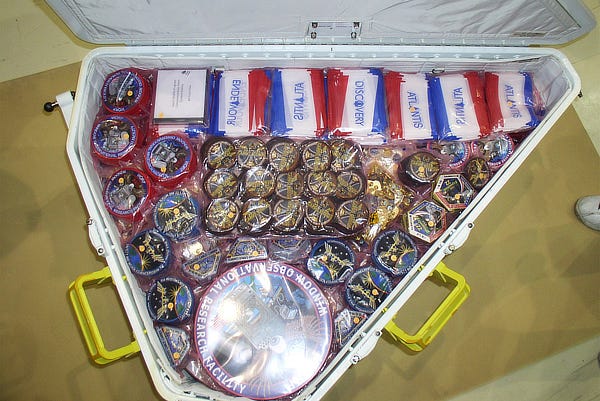
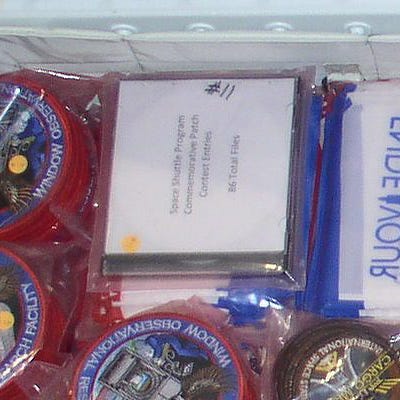
Once packed and closed, the stowage box was carefully bolted into the payload bay between the starboard braces adjacent to Atlantis’ docking airlock.

The Dream is Alive
My passion for spaceflight originated in the 1960s and 70s when I followed the Apollo missions on TV and learned about them in books and magazines. I have long wanted to be able to design a mission patch and have it flown into space.
This was the second creation of mine to make the journey into the space beyond our planet. And while my design never made it quite to “mission patch” status, I am very proud and grateful to have had the privilege of vicariously joining the crew of Atlantis on STS-132. I felt a special connection to the mission and to the astronauts who made one of the last flights of the space shuttle program. Thank you, NASA, for taking my artwork to new heights!
During its 12 days in space, Atlantis along with the artwork made 186 orbits of the planet and traveled 4,879,978 miles (7,853,563 km). Atlantis ended up flying one last time on the final mission of the Space Shuttle program, STS-135 on July 8, 2011. My wife and I were there again – this time to witness the end of an incredible era in spaceflight.
Whenever I have a chance to see Atlantis on display at the Kennedy Space Center, I like to look at the place where the triangular stowage box was attached and remember the day my artwork launched into space.
And, reminding me every day is this photo, taken by Garrett Reisman during the STS-132 mission. I have it as the backdrop on my computer display.

Art News
I am very happy that I will once again be exhibiting my space-inspired artwork at the U.S. Astronaut Hall of Fame Induction weekend events this year in Cocoa Beach, Florida. I will be joining notable space artists Chris Calle, Lee Wilson, and astronaut/artist Nicole Stott. This year will also feature artwork by astronaut scholar, Will Jarvis.
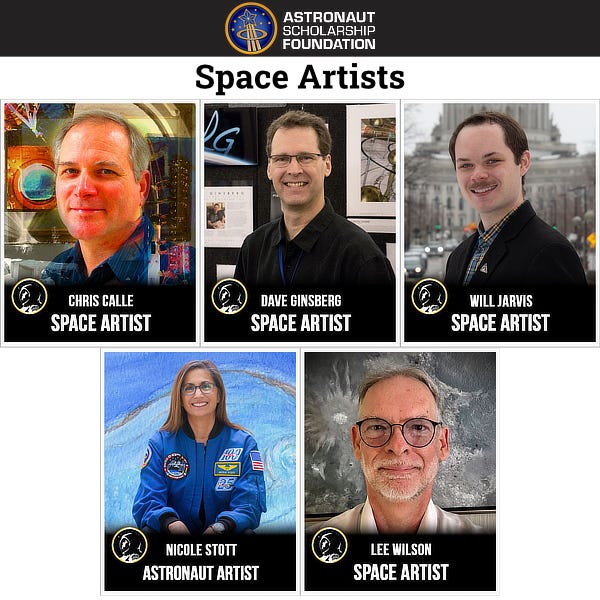
This year’s celebrations will be held from May 29 through 31, 2025. This will be my third time exhibiting at an ASF event.
The space art reception will be open to the public. Admission is $25, and tickets will be available at the door on May 30. The reception will take place in the Horizons Ballroom of the Hilton Cocoa Beach Oceanfront located at 1550 North Atlantic Ave, Cocoa Beach, Florida, 32931.
The events are organized by the Astronaut Scholarship Foundation (ASF), a non-profit organization that provides scholarships to the brightest and most talented college students in science, technology, engineering and mathematics.4 I am proud to be able to support the ASF in their educational mission. A portion of my sales proceeds will go directly to the ASF organization.
Merch of the Month
Double Boosted Metal Print
Relive the thrill of watching the Space Shuttle launch every day with this high-quality wall art in your home or office.
My space-inspired art portfolio can be found at pixel-planet-pictures.com.
Do you know fellow Space Geeks who might enjoy Creating Space? Invite them into this space, too!
Did you miss a post? Catch up here.
If you enjoyed this article please hit the ‘Like’ button and feel free to comment.
All images and text copyright © Dave Ginsberg, unless otherwise noted. All rights reserved.
At the time of the contest, the last planned flight of the Space Shuttle was to be in 2010.
The contest organizers placed a limit of one design per entrant.
Pearlman, Robert, collectSPACE, NASA announces winning patch design in end-of-shuttle contest, February 17, 2010





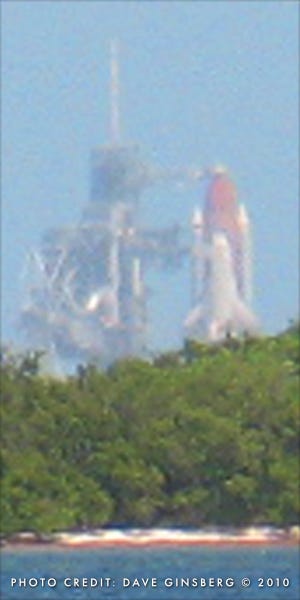
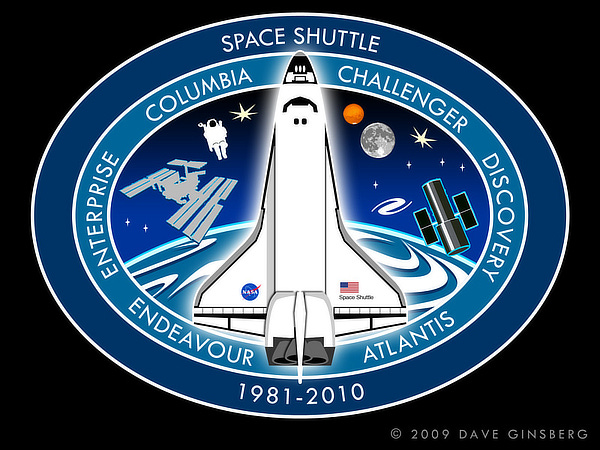
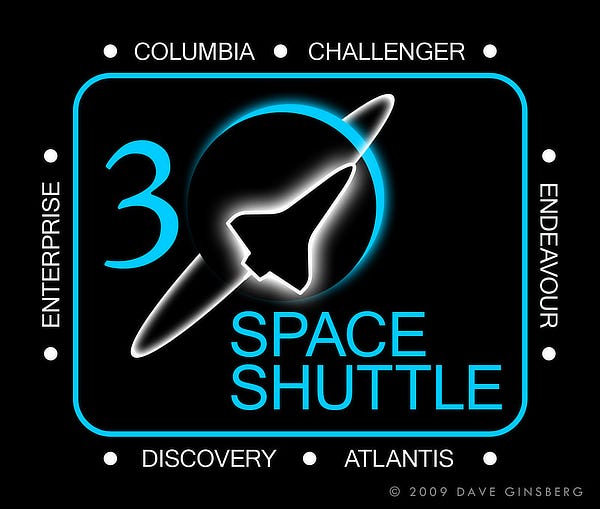
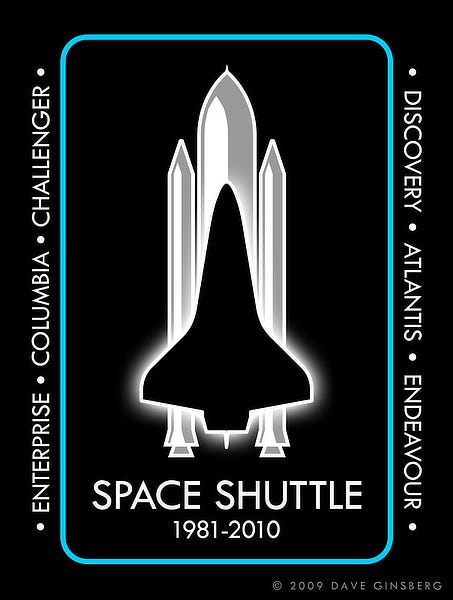

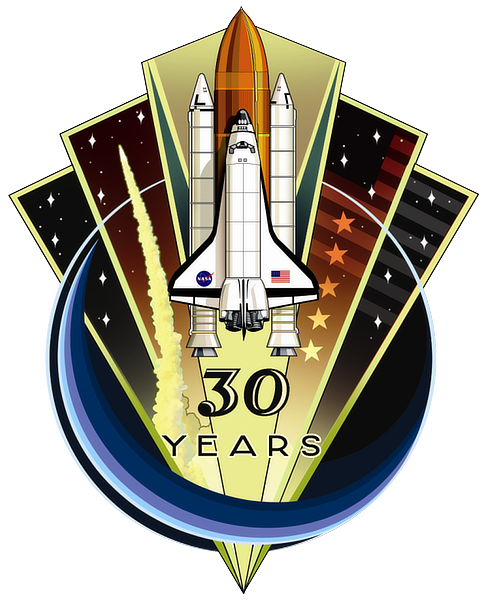
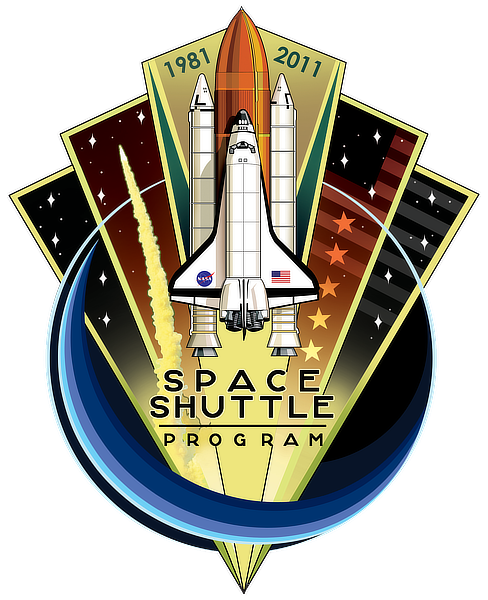
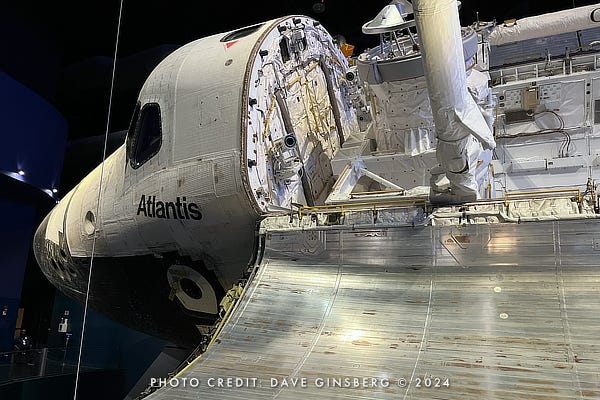






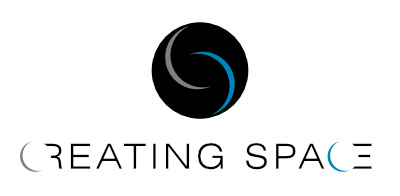
Wow Dave!!! I never knew you did that!!! CONGRATULATIONS!!! I like your #1 entry the best. It should have won in my opinion! My 2nd favorite was your 2nd creation. I wish you had won but at least your art made it to new heights!! 🙄🤔🤦
I used to draw the JPL NASA swoosh logo over and over again in 7th grade. Perhaps I shouldn’t admit that. Regardless, your art is SWEEEEEEEET!